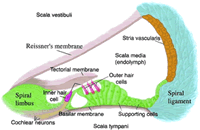Summary

The overall goal inhuman genetic research is to understand the biological function of normal genes, and how once perturbed, they lead to a diseased state. Errors in our genes, or mutations, often cause one of the most common sensory defects, the loss of hearing. Hereditary sensorineural hearing loss affects approximately 3% of the population in Palestine and can reach 15% in isolated communities. There are many sociological implications of hearing loss, including problems of isolation and loneliness for those losing their hearing later in life, and comparatively poor educational achievements, especially for those losing their hearing early in life. The goal of this research project is to identify and understand the molecular basis of mutations in deafness genes in the Palestinian deaf populations The identification of mutant genes in the Palestinian populations will allow for early intervention and aid the individuals affected. Eventually the study of the genes causing deafness will allow us to learn how normal hearing functions. Understanding the normal function of the genes, and the mutations that cause hearing loss, will enable investigators to suggest new means of treating sensorineural deafness. Therefore, these studies will lead to better diagnosis of inherited deafness and help improve the quality of life of deaf individuals in the Palestinian populations.
Background Information and Justification
The name designated to our part of the world, “The Middle East, disguises the important differences within its limits. For the past 5000 years, the eastern shores of the Mediterranean have seen the migrations of many different peoples who have come and stayed. These distinct populations have lived in their own villages, relatively unaffected by the international trade routes which transverse the area. Culturally, they were, and many still are, organized into tribes and large families, only few of which may populate a village. Marriages have been arranged within the tribe, leading to a very high incidence of consanguineous marriages. Because of this region’s unique characteristics, of diverse populations that have kept themselves quite isolated from each other, despite their geographic proximity, some serious public health issues of genetic origin (ex. deafness and breast cancer) have been observed and carefully documented.

Consanguinity, which is a nearly universal feature of traditional societies, greatly magnifies these genetic diseases into serious public health problems. Paradoxically, consanguinity facilitates discovery of unknown genes of these diseases by providing a sufficient number of related affected individuals and their unaffected family members that is necessary for linkage analysis. This proposal is the emerging field of the human genome project. More specifically, it deals with the molecular description and diagnosis of genetic hearing loss that have risen to a high frequencies within Palestinian populations in order to permit genetic counseling of potentially affected families and individuals.
Recent breakthrough developments in the area of human genetics and current advances in biotechnology have raised the urgent demand for laboratories which will specialize in implementing these methodologies for the benefit of general society. The research proposal outlined here will enable a Palestinian investigator to interact and collaborate scientifically with Dr. Mary King Lab for the common good of the people. The exchange resources and research experience will benefit both laboratories and institutions, with the goal of improving the health of individuals from both areas.
Deafness is the most common form of sensory impairment in humans. Approximately 3 out of 1000 individuals is born deaf, while about 1 out of 10 is deaf or hard of hearing. Deafness accounts for a frequency that reaches 15% in certain geographic area in Palestine. Hearing impairment can result from a variety of injuries or diseases, and occur both in association with other symptoms in the form of syndromic deafness, or as an isolated finding, in the form of non-syndromic deafness. Despite its prevalence in the human population, very little is known about the molecular events leading to deafness and about the genes that control normal hearing. An understanding of this process will enable early diagnosis of hearing loss and thus provide a means to treat or cure this problem.
The first reports of genes involved in non-syndromic deafness have appeared recently, and so we now have the first opportunity to screen the human deaf population for mutations in these genes. Myosin VI, an unconventional myosin, was isolated during a positional cloning approach to identify the gene encoded by the mouse recessive deafness mutation, Snell’swaltzer (sv). The human myosin VI (MYO6) cDNA has recently been cloned and characterized, and the genomic structure is currently being determined. Myosin VIIA (MYO7A) was found to be defective in shaker-1 (sh1) mice, an autosomal recessive mutation characterized by deafness and vestibular dysfunction and in human Usher syndrome type 1B, an inherited disease characterized by deafness, vestibular dysfunction and retinitis pigmentosa. Mutations in myosin VIIA were recently reported in a human autosomal recessive deafness locus, DFNB2, and in small families with non-syndromic deafness. Connexin 26(CX26) mutations were found in families exhibiting both autosomal and recessive forms of non-syndromic deafness.
The most recent deafness locus (DFNA1) to be cloned is diaphanous (DIA), found to be mutated in a Costa Rican kindred. The involvement of an unconventional myosin in both human and mouse deafness (myosin VIIA), the similarity of the human and mouse auditory systems, and the existence of additional unidentified human deafness loci suggest that MYO6 will also be involved in human deafness. The cloning of the human MYO6 cDNA makes it possible to determine if MYO6 is altered in human deafness disorder. I plan to perform mutation screening to identify MYO6 mutations in the human deaf population in Palestinian populations. In addition, I will screen these families for mutations in MYO7A, CX26 and DIA using different techniques. This field is expanding rapidly, and I expect more genes to be identified in the near future. As these reports become available, I will incorporate these mutation screens in my future project. This will increase the chances of finding mutations causing deafness in the families.
Hereditary Hearing Loss

In a pilot study that we conducted at Human Genetics Lab at Bethlehem University, we have studied about 50 different families with hearing impairment. Only 22% of these families harbored mutations in this gene, with 5 different mutations found in the population one of which, 35delG is responsible for about 50% of the cases with hearing loss attributed to this gene.
Work was done on a number of selected families that had more than two affected individuals and did not show any GJB2 mutations neither in the coding sequence nor in the upstream region. The idea was to test possible linkage of hearing impairments in these families to some of the known deafness genes. We could not establish any linkage in the screened families with any of the genes and loci that looked at. One Palestinian family under went a whole genome scan, in collaboration with the University of Washington, Seattle, where a novel deafness locus has been found (DFNB28). Our efforts now focus on finding the gene responsible for deafness in this family as well as screening other Palestinian families for possible linkage to the same loci.
Funded: Fogarthy International Award (FIRCA pro gram-USA), 2000-2003
Expected benefits of Project
– Primary Beneficiaries. The primary beneficiaries of this research project will be the deaf and hearing impaired population of the West Bank and Gaza Strip. Deafness is the most common form of sensory impairment in humans. There are many sociological implications of hearing loss, including problems of isolation and loneliness for those losing their hearing later in life and comparatively poor educational achievements, especially for those losing their hearing early in life. In ours and most societies in the world, the ability to hear is the �normal� way of life, whereas those who have difficulty hearing must conform in order to succeed both socially and professionally in life. Despite its prevalence in the Palestinian population very little is known about the molecular events leading to deafness and about the genes that control normal hearing. problem. Success in prevention through population screening and prenatal diagnosis largely hinges on an accurate knowledge of phenotype / genotype correlation and this project should provide such an understanding. It should be obvious, however, that the only realistic long term solution for deafness is the effective therapy through a detailed understanding of the molecular mechanisms, a challenge similar to that faced for many other genetic diseases in the whole World.- While this project is going to concentrate on deafness, it will undoubtedly have considerable impact on the introduction of relevant techniques and molecular diagnostic to my research lab at Bethlehem university. The lab is expected to constitute the missing link between these methodologies and its needed society value in the context of training qualified manpower, data evaluation and quality control of clinical results. In addition, the lab will provide the frame work that this new information is used in the most responsible manner and according to the guidelines for genetic diagnosis and counseling. Bethlehem university has approved a new program in medical biotechnology. This research study will enrich both teaching and laboratory capabilities of this program.


